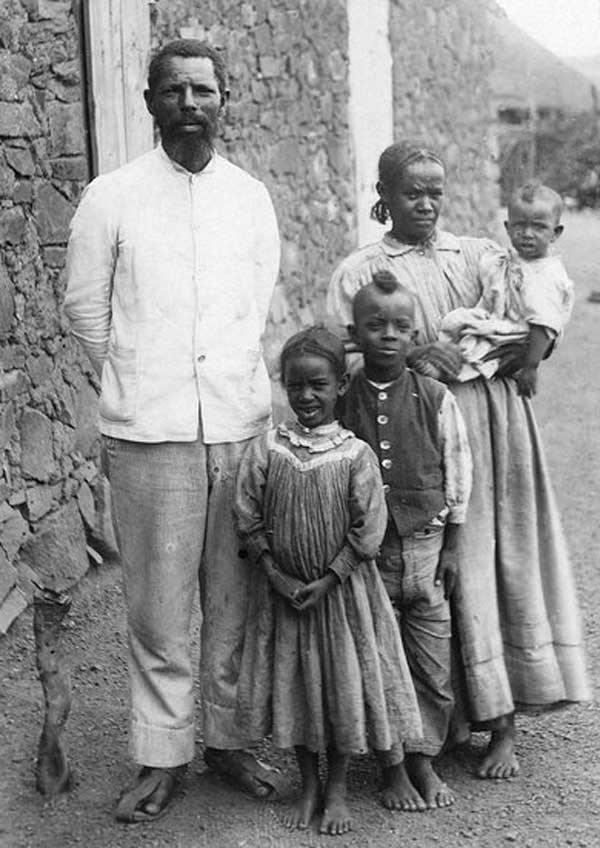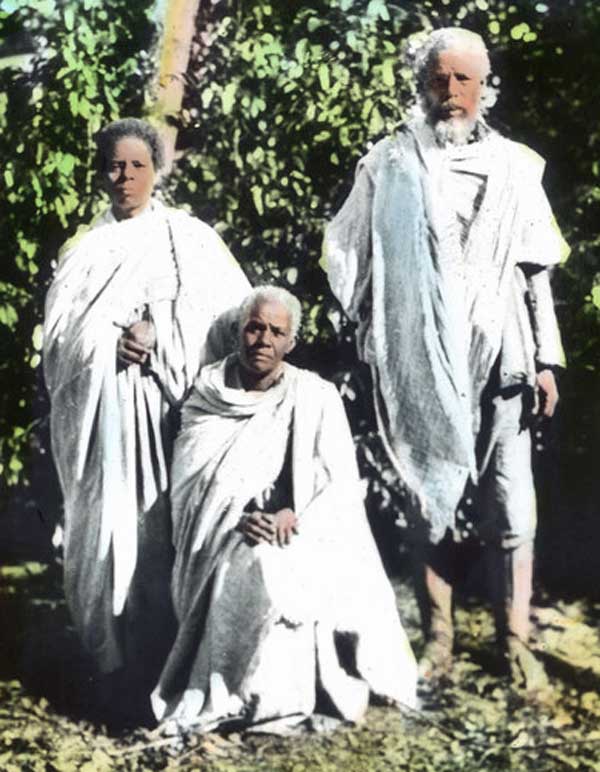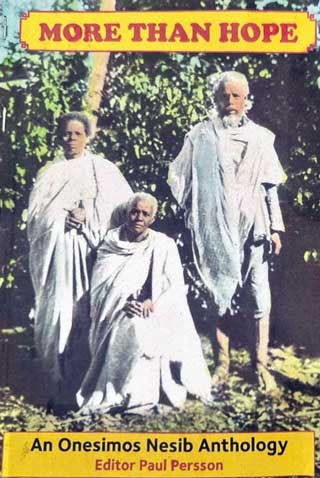Onesimos Nesib (Qubee: Onesimoos Nasiib) was born in Hurrumu, former Yayu district, Illubabor Zone of Oromia Region in 1855/56. His birth name was Hiikaa [translator, problem solver, one who liberates]. Onesimos is the biblical name he received after baptism in 1872. Like the main character in Paul’s letter to Philemon, Onesimus had been enslaved. Hiikaa was ransomed by the orientalist and French vice-consul Werner Munzinger in Massawa in 1870 and then attended the nearby “School for Freed Man” established by the Swedish Evangelical Mission (SEM). From 1876 until 1881, Onesimos studied at Johannelund Missionary Training Institute.
Having returned from Sweden, Onesimos Nesib participated in the SEM expedition to reach Oromia via Khartoum and Famaka (Sudan). However, the team did not reach its destination. Seriously ill and exhausted, Onesimus arrived back in Imkullu (near Massawa) about the middle of July 1882.
A few weeks later, Onesimos started to translate Christian literature into Oromo. The first book printed at the local mission press was a hymn book called Faarsaa fi Weedu [Hymns and Songs], 1886.
In 1881, his former teacher and SEM leader in Eritrea and Ethiopia, Rev. Bengt P. Lundahl, had published an Amharic hymn book, Yegubaé Mezmurat. From these 41 congregational songs, Onesimos translated 26 into Oromo. He selected 75 songs from various Swedish and English hymn books and also translated them into Oromo. In total, the first edition of Onesimos’ hymnal thus contained 101 hymns, including two by Martin Luther (“A Mighty Fortress” and “Dear Christians, One and All, Rejoice”).
Onesimos Nesib constantly revised his Oromo hymnal. Based on the enlarged manuscript Onesimos had completed in 1927, Rev. Martin Nordfeldt and his wife Ingeborg published a revised edition in 1935. They included some of Onesimos’ new songs but replaced some of his other hymns that had probably been composed for singing to traditional Oromo melodies. An Oromo translation of parts of the liturgy was also added. The Nordfeldt family had made their home in Nekemte from 1924- and learned Oromo from Onesimos and his colleague, Aster Ganno.
Onesimos Nesib had left for Illubabor via Djibouti in 1903, but settled at the invitation of Governor Kumsaa Moroda in Nekemte. In 1904, Onesimos received a plot for his house and a school in Nejo but had to return to Nekemte in early 1906. He stayed there, teaching reading and writing Oromo at an elementary school and proclaiming the Good News of Jesus Christ, until he died in June 1931.
Onesimos could play the harmonium (pump organ) and brought one with him when he returned from his study in Sweden. Unfortunately, the harmonium was stolen during his second missionary expedition to reach Oromia in 1885/86.
Onesimos Nesib’s legacy as an Oromo Bible translator, evangelist and teacher is well-known. However, there is still much to learn about Onesimos as the father of Oromo gospel music. Further studies are most welcome.
Video
» Watch videos on Onesimos Nesib
Pictures

(from SEM Archives; adapted)

(coloured photograph from SEM Archives; adapted)
Further study
1. ONESIMOS’ WRITINGS IN OROMO
1.1. Hymn books
- Faarsaa fi Weedu [(Oromo) Hymns and Songs]. Translated by Onesimos Nesib. Imkullu (Massawa): Swedish Evangelical Mission, 1886. [101 hymns; without music notation]
» View book
» View music book (publ. in 2022)
- Galata Waaqayyo Gooftaa Machaa [Praise God, Lord of hosts].
Edited by Martin Nordfeldt. Addis Ababa: Swedish Evangelical Mission, 1935. [116 hymns; based on the expanded edition left by Onesimus at his death in 1931]
» View book
1.2 Additional publications translated / edited by Onesimos Nesib
- Kakuu Haaraa: Innis Kan Gooftaa Keenyaa Kan Fayisaa Keenyaaa KaYasuus Kiristoos Wangeela Qulqulluu Macaafota Ergamtootas [The New Testament of Our Lord and Savior Jesus Christ]. Imkullu (Massawa),1893.
(2nd edition: St. Chrischona: Mission-Press,1899 [partial edition of the full Bible])
- Macaafa Qulqulluu: Innis Macaafa ta Kakuu Moofaa fi Harawaa
[The Holy Bible: The Old and New Testament]. St. Chrischona: Mission-Press, 1899 (at the expense of the British & Foreign Bible Society).
» View Genesis – Deuteronomy / Joshua – Esther /
Job – Songs of Songs / Isaiah – Malachi / Matthew – Revelation
- Katekismos [Catechism]. St. Chrischona: Mission-Press, 1899.
» View book
1.3 Publications translated / authored by Onesimos Nesib and Aster Gannoo
- Jalqaba Barsiisaa: The [Oromo *] Spelling-Book [and Reader].
Imkullu: Swedish Mission Press, 1894.- View book
- View remarks in letter to EFS in Mission-Tidnings (online)
- View traditional songs published in Paulitschke, Ethnographie, vol. 2 (online)
- A Qubee (Roman script) edition was published in Ethiopia in 2022 [For further information, please contact Oromo Bible Society]
- Garaani Namaa Mana Waaqayyoo yookis Idoo Bultii Seexanaa
[Man’s Heart either God’s Temple or Satan’s Abode]. St. Chrischona: Mission-Press, 1899.
» View online (ALVIN Portal)
- Si’a lama Oduu Shantamii lama [Dr. Barth’s Bible-Stories]. St. Chrischona: Mission Press, 1899. [1st draft by Aster Gannoo]
» View book
1.4 Unpublished manuscripts
- Oromo manuscripts by Nils Hylander
(in cooperation with Onesimos Nesib, Aster Gannoo et al.)
» View online (ALVIN Portal) - Oromo manuscripts dictated by Onesimos Nesib to Dr. Adolf Walter Schleicher in 1894 (Vienna University)
» See overview - “Brief anthology of Oromo love songs collected by the Swedish Mission around 1890”. Typed in Ethiosemitic script. Deposited at the SEM Archives (EFS 1a P35 F1; not yet available online).
- “Svensson, A., Swedish missionary: letter from Asmara (Eritrea) 1892, about [Oromo].” British & Foreign Bible Society Archives, Univ. of Cambridge. Ref. Code: GBR/0374/BFBS/BSAX/1/S
1.5 Manuscripts probably lost
Onesimos Nesib. Diary for 1928-1931 [i.e., the year he passed away].
- Quoted in M. Nordfeldt, “Axplock ur Onesimus dagbok”, Missions-Tidning Budbäraren 1933, 632-633 [Online available at SEM Archives]
Onesimos Nesib. Enlarged version of his hymnbook Faarsaa fi Weedu (1886), completed in Nekemte in 1927.
- Mentioned in Arén, Envoys, p. 330, fn. 136. [View online].
- According to a letter of Rev. M. Nordfeldt, he and his wife produced 100 copies of a selection of 24 hymns by hectograph in 1927 (50 copies for Nekemte, 50 copies for Najo)
2. ONESIMOS’ WRITINGS IN LANGUAGES OTHER THAN OROMO
Onesimos Nesib. “Reminiscenses”. English translation of a Swedish article in Missions-Tidning, 1876, 92f [Read online]
Persson, Paul, ed. More than Hope: An Onesimos Nesib Anthology. Addis Ababa 2024. [To be translated into Oromo etc.]

3. SOURCES FOR ONESIMOS’ HYMNALS
» See overview
4. SECONDARY LITERATURE
» View bibliography
— Marianne Nilsson / Stefan Ritter
Note: Where [Oromo *] is written in square brackets, the word “Galla” is found in the original. While this foreign designation was common in literature until World War II, it is now considered derogatory and should be replaced by the self-designation “Oromo”.